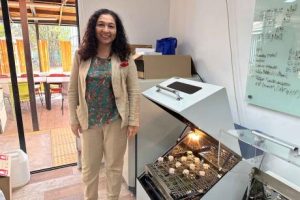The University of Santiago de Chile and mining companies are working on the development of a technology with low environmental impact to obtain copper, through the processing of Chalcopyrite, a mineral that is very abundant in the earth’s crust and contains copper sulfide.
Paola Armijo, USACh Journalist.- This collaboration occurs within the framework of applied research “Development of a new chalcopyrite leaching process in three stages that allows the efficient extraction of copper on a pilot scale”, led by Dr. Lilian Velásquez, academic and researcher at the Faculty of Engineering, who has extensive experience in projects for the mining industry.
The initiative is financed by ANID and is supported by Minera Paicavi, the German chemical company BASF, the Ciptemin Integrated Mining Technology Piloting Center and the Technology Management Department (DGT), of the Vice-Rector for Research, Innovation and Creation.
Collaborating companies such as Antofagasta Minerals, WIM and a group of international researchers such as Dr. Jochen Petersen from the University of Cape Town in South Africa, Dr. Miao Chang from CSIRO and Dr. Rahul Ram from BHP Billiton, both joined. from Australia.
Empowering green mining
This research, which began in October 2022, will culminate at the end of 2024. Its focus is to work on a new and more sustainable alternative for the hydrometallurgical process of chalcopyrite, which ultimately has an impact on promoting greener mining.
As explained by Dr. Lilian Velásquez, this mineral is commonly processed “by way of concentration and then melting it down, which can generate environmental contamination due to the production of toxic gases. Also, large volumes of water are required to concentrate it.”
To solve this problem, the project proposes the use of seawater, discarded salts, brine from desalination companies and a smaller amount of acid solutions. “We also contribute to the circular economy, by using a reagent obtained from agribusiness waste,” he emphasized.
Linkage and participation of the industry
The process to be implemented consists of three work stages: flooding, temperate rest and leaching.
At the laboratory level, each of the phases has already been tested separately, obtaining optimal results. For this reason, the current objective of the research team led by Dr. Velásquez is to connect them and subsequently create a prototype in an industrial environment that allows “demonstrating that we can dissolve chalcopyrite and obtain copper,” said the academic. .
Both for the current work and in the creation and testing of the pilot, we have the support of the participating entities. In the case of Minera Paicavi, it has supplied large quantities of chalcopyrite to be used in laboratory experiments and, in addition, it will make its facilities available to test the technology on a pilot scale.
Ciptemin also has a key role, which will contribute by validating this development with the Usach seal. “BASF company provides reagents to hydrometallurgical plants in our country and for this initiative, it contributes with human resources capacity, having an expert team to work with us”, added the researcher.
Gender equity and knowledge
One of the aspects highlighted by Dr. Velásquez in relation to the initiative is the incorporation of a “gender component, where we hope to encourage, motivate and empower our students and researchers, which we hope will be an example for new research that can be generate nationally and internationally.
He added that “although the University-industry relationship further facilitates the execution of the research or there is the opportunity to jointly apply for competitive funds, there are also other benefits for the Academy such as the transfer of knowledge to the student body through chairs , professional practices, seminars and in the elaboration of a memory”.
If you want to know more about the applied research projects of our Campus, you can visit the News section of the Technology Management Department website.






![[Img #74662]](https://thelatestnews.world/wp-content/uploads/2024/12/Organisms-with-the-shortest-life-150x150.jpg)






![[Img #74662]](https://thelatestnews.world/wp-content/uploads/2024/12/Organisms-with-the-shortest-life-300x200.jpg)

